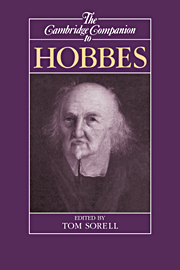Book contents
- Frontmatter
- Introduction
- 1 A summary biography of Hobbes
- 2 Hobbes's scheme of the sciences
- 3 First philosophy and the foundations of knowledge
- 4 Hobbes and the method of natural science
- 5 Hobbes and mathematics
- 6 Hobbes on light and vision
- 7 Hobbes's psychology
- 8 Hobbes's moral philosophy
- 9 Hobbes's political philosophy
- 10 Lofty science and local politics
- 11 Hobbes on law
- 12 History in Hobbes's thought
- 13 Hobbes on rhetoric
- 14 Hobbes on religion
- Bibliography
- Index
6 - Hobbes on light and vision
Published online by Cambridge University Press: 28 May 2006
- Frontmatter
- Introduction
- 1 A summary biography of Hobbes
- 2 Hobbes's scheme of the sciences
- 3 First philosophy and the foundations of knowledge
- 4 Hobbes and the method of natural science
- 5 Hobbes and mathematics
- 6 Hobbes on light and vision
- 7 Hobbes's psychology
- 8 Hobbes's moral philosophy
- 9 Hobbes's political philosophy
- 10 Lofty science and local politics
- 11 Hobbes on law
- 12 History in Hobbes's thought
- 13 Hobbes on rhetoric
- 14 Hobbes on religion
- Bibliography
- Index
Summary
Like many of his contemporaries, Hobbes showed a keen interest in optics. In fact, the question of the nature of sensory perception was the first philosophical problem he pondered, and his search for an explanation of vision led him to believe that all natural phenomena could be reduced to local motion of material bodies. Hence, from the very start, his theory of light and vision served as a model for his theories of natural phenomena in general. Apart from speculations on light and vision expressed in passing in a number of optical works, Hobbes wrote three specifically optical tracts: the Tractatus Opticus I (ca. 1640), the Tractatus Opticus II (1644), and A Minute or First Draught of the Optiques (1646). Although these works were written in the 1640s, Hobbes conceived the main principles of his optics early in the 1630s.
Hobbes's earliest attempt at a systematic account of his natural philosophy probably dates from around 1630. It was published in 1889 by Ferdinand Tönnies as "A short tract on first principles.” This text consists of three sections, each composed of one or more principles followed by a number of conclusions. In the first section, Hobbes presents the conceptual building blocks and principles of a mechanical explanation of natural operations. The things constituting nature are defined in terms of their relationship qua being, operation, and generation.
- Type
- Chapter
- Information
- The Cambridge Companion to Hobbes , pp. 129 - 156Publisher: Cambridge University PressPrint publication year: 1996
- 8
- Cited by

